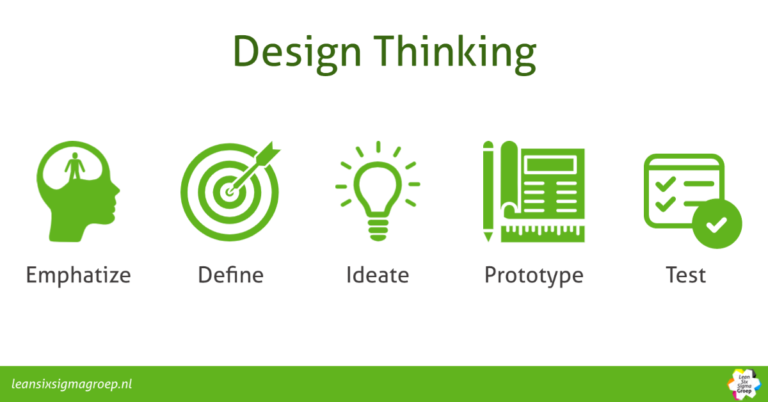What is Design Thinking?
Think outside the boxDesign Thinking is an iterative process used to solve complex problems (also known as wicked problems). The user and his needs are central to this; Design Thinking is about understanding the people for whom a product or service is being developed.
Why Design Thinking?
It may sound logical to put the customer’s needs first, but in practice it is often not. People are very inclined to think in patterns and assumptions. It is extremely difficult to put those assumptions aside and to arrive at innovative solutions based on the needs of a user. Design Thinking is often referred to as ‘outside the box thinking’. Designers try to develop new ways of thinking and break away from the dominant or more common problem-solving methods.
Design Thinking is both a way of thinking and working, as well as a collection of practical methods that stimulate you to explore new alternatives in order to arrive at better solutions.

5 phases of Design Thinking
- Empathize: empathize with your users. Research the wishes and needs of the users. What are their challenges and what are their needs? In this phase you stay away from solutions, but you really delve into the problem.
- Define: The second stage in the Design Thinking process is devoted to defining the problem. By interpreting the findings from the Empathize phase and recognizing patterns, you formulate the user problem to be solved. At the end of this phase you will have a clear problem statement. The key here is to phrase the problem in a user-centric way. Once you’ve formulated the problem, you can start coming up with solutions and ideas—which brings us to phase three.
- Ideate: The aim of the Ideate phase is to generate as many solutions to the problem as possible and present them to the user. Frequently used techniques in this phase are brainstorming sessions, pink cloud thinking or the ‘crazy eight’, in which 8 solutions have to be drawn in 8 minutes.
- Prototype: This is the phase in which learning and experimentation are central. You try to create and test a number of simplified and cheap versions of your idea within your team in a short time. This is a working prototype, not a description of the product or service. The Prototype phase is essential to test each solution and reveal any limitations and flaws. During this phase, the proposed solutions can be accepted, improved, redesigned or rejected, depending on how they do it in prototype form. The result of this phase is to have an idea of how users would react to the chosen solution (behavioural, emotional and intellectual) and to know the limitations of the design.
- Test: after the Prototype phase, the Test phase follows. The product or service is tested by real users. Although this is the final stage, it is often not the end point of the design process. Often the results of the Test phase lead back to a previous step in the process and to insights that you need to redefine the original problem statement or to come up with new ideas. This makes Design Thinking an iterative process, in which there is constant testing and experimentation in co-creation with the user until the perfect solution is found.
In short, Design Thinking gives us a means to dig that little bit deeper and discover new ways to improve user experiences.
Video: In his 2009 TED talk, Design Thinking pioneer Tim Brown discusses the value of Design Thinking in solving highly complex challenges.
Example Design Thinking
In 2009, Airbnb was on the brink of bankruptcy. The company’s revenue was about $200 a week. Split between three young founders living in San Francisco, it was quite a loss.
One afternoon, the team with Paul Graham (from Y Combinator) was doing search results for listings in New York City, trying to figure out what wasn’t working and why they weren’t growing. After spending some time on the site with the product, Gebbia (co-founder and chief product officer) had an important insight. “We have noticed a pattern. There is a similarity between these 40 offers. The similarity is that the photos were bad. The pictures weren’t great pictures. People used their camera phones or used images from classified sites. It was actually no surprise that people weren’t booking rooms because you couldn’t even really see what you were paying for. ”
Learning and experimenting
Graham threw a completely non-scalable and non-technical solution to the problem: travel to New York, rent a camera, spend some time with clients listed on the website, and replace amateur photography with beautiful, high-resolution photos. The three-person team took the next flight to New York and processed all the amateur photos into beautiful images. Originally, there was no data to support this decision. They just went and did it. A week later, the results were in: by improving the photos, the weekly revenue doubled to about $400 a week. This was the first financial improvement the company had seen in more than eight months. They knew they were onto something.
Gebbia said the team initially believed that everything they did should be “scalable.” It wasn’t until they gave themselves permission to experiment with non-scalable changes in the business that they climbed out of what they called the “bin of grief.”